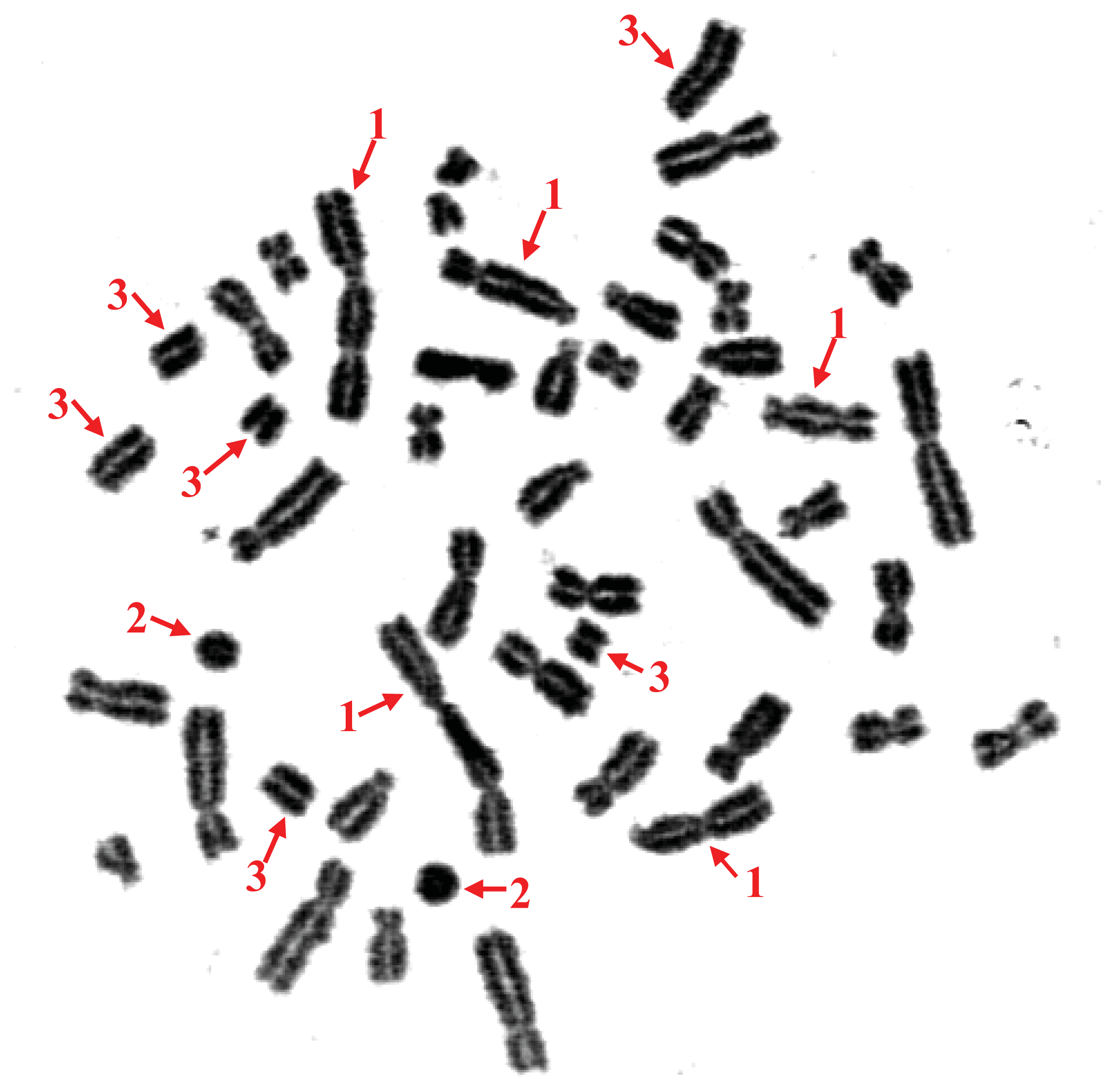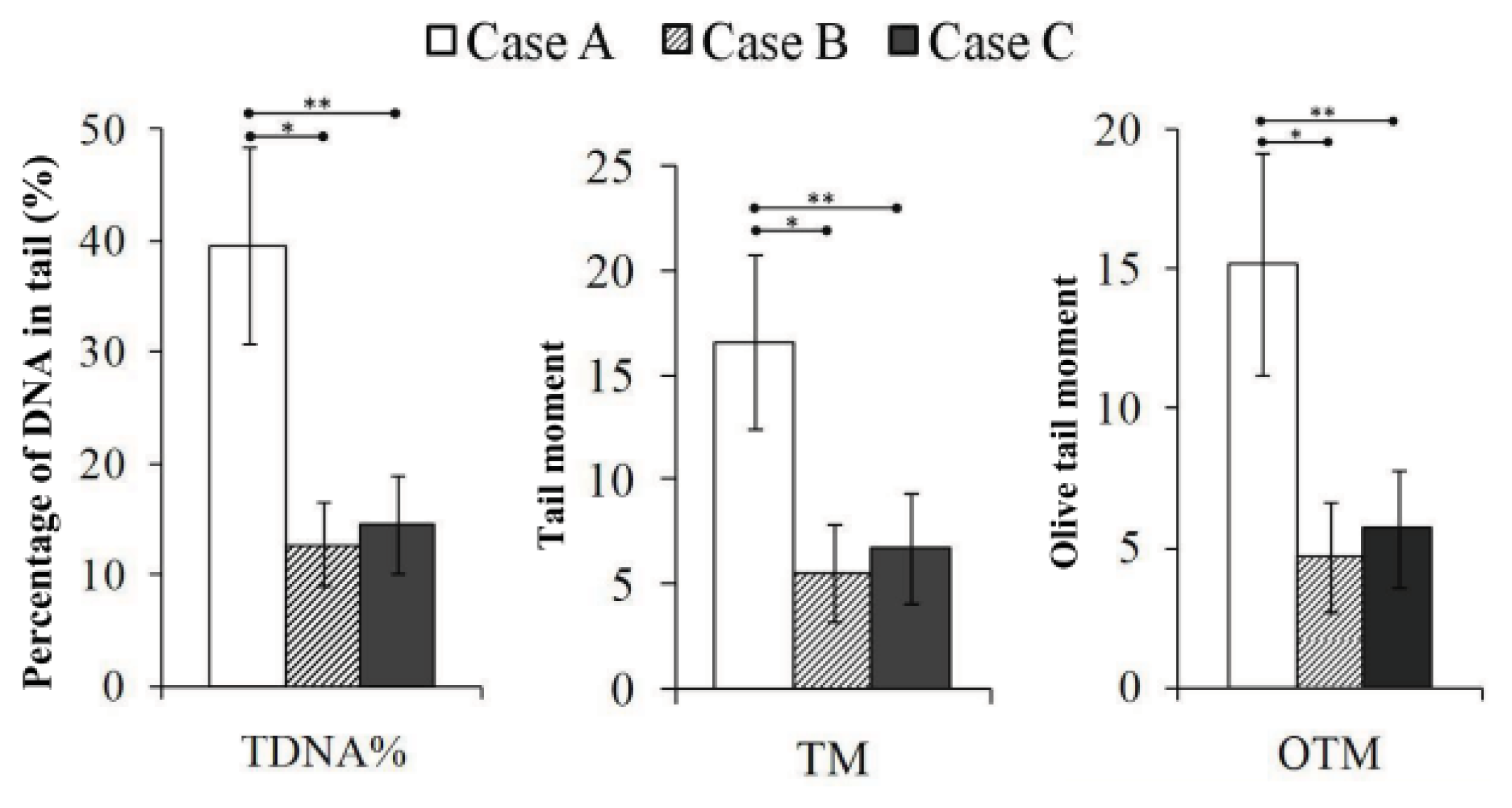Cytogenetic Abnormalities in Lymphocytes from Victims Exposed to Cobalt-60 Radiation
Abstract
:1. Introduction
2. Results and Discussion
2.1. Chromosome Aberration in Leukocytes Derived from Three Victims
2.2. CBMN Assay in Three Victims
2.3. DNA-DSBs Evaluated by Neutral Comet Assay
3. Experimental Section
3.1. Subjects
3.2. Reagents and Instruments
3.3. Cell Culture and Sample Preparation
3.4. Comet Assay
3.5. Statistical Analysis
4. Conclusions
Acknowledgments
Conflicts of Interest
References
- Wolbarst, A.B.; Wiley, A.L., Jr; Nemhauser, J.B.; Christensen, D.M.; Hendee, W.R. Medical response to a major radiologic emergency: A primer for medical and public health practitioners. Radiology 2010, 254, 660–677. [Google Scholar]
- Djounova, J.; Guleva, I.; Negoicheva, K.; Mileva, I.; Panova, D.; Rupova, I.; Gigov, I. Initial medical diagnosis of patients severely irradiated in the accident with 60Co in Bulgaria. Radiat. Prot. Dosimetry 2012, 151, 640–644. [Google Scholar]
- Gupta, M.; Srivastava, N.; Dutta, S.; Shukla, S.; Dutta, A.; Verma, S.; Devi, M. Blood biomarkers in metal scrap workers accidentally exposed to ionizing radiation: A case study. Hum. Exp. Toxicol. 2013. [Google Scholar] [CrossRef]
- Agrawala, P.K.; Adhikari, J.S.; Chaudhury, N.K. Lymphocyte chromosomal aberration assay in radiation biodosimetry. J. Pharm. Bioallied. Sci. 2010, 2, 197–201. [Google Scholar]
- Sasaki, M.S. Cytogenetic biomonitoring of humanradiation exposures: Possibilities, problems and pitfalls. J. Radiat. Res 1992, 33, 44–53. [Google Scholar]
- Lloyd, D.C.; Edwards, A.A. Biological Dosimetry after Radiation Accidents. In Chromosome Aberrations: Basic and Applied Aspects; Obe, G., Natarajan, A.T., Eds.; Springer: Berlin, Germany, 1989; pp. 212–223. [Google Scholar]
- Wojcik, A.; Gregoire, E.; Hayata, I.; Roy, L.; Sommer, S.; Stephane, G.; Voisin, P. Cytogenetic damage in lymphocytes for the purpose of dose reconstruction: a review of three recent radiation accidents. Cytogenet. Genome. Res 2004, 104, 200–205. [Google Scholar]
- Thierens, H.; de Ruyck, K.; Vral, A.; de Gelder, V.; Whitehouse, C.A.; Tawn, E.J.; Boesman, I. Cytogenetic biodosimetry of an accidental exposure of a radiological worker using multiple assays. Radiat. Prot. Dosimetry 2005, 113, 408–414. [Google Scholar]
- Cytogenetic analysis for radiation dose assessment, a manual. Available online: http://www-pub.iaea.org/MTCD/Publications/PDF/TRS405_scr.pdf (accessed on 14 August 2013).
- Vral, A.; Fenech, M.; Thierens, H. The micronucleus assay as a biological dosimeter of in vivo ionising radiation exposure. Mutagenesis 2011, 26, 11–17. [Google Scholar]
- The radiological accident in Istanbul. Available online: http://www-pub.iaea.org/MTCD/Publications/PDF/Pub1102_web.pdf (accessed on 14 August 2013).
- Harreus, U.A.; Kleinsasser, N.H.; Zieger, S.; Wallner, B.; Reiter, M.; Schuller, P.; Berghaus, A. Sensitivity to DNA-damage induction and chromosomal alterations in mucosa cells from patients with and without cancer of the oropharynx detected by a combination of comet assay and fluorescence in situ hybridization. Mutat. Res 2004, 563, 131–138. [Google Scholar]
- Hoffmann, H.; Speit, G. Assessment of DNA damage in peripheral blood of heavy smokers with the comet assay and the micronucleus test. Mutat. Res 2005, 581, 105–114. [Google Scholar]
- Paulraj, R.; Behari, J. Single strand DNA breaks in rat brain cells exposed to microwave radiation. Mutat. Res 2006, 596, 76–80. [Google Scholar]
- Verde, P.E.; Geracitano, L.A.; Amado, L.L.; Rosa, C.E.; Bianchini, A.; Monserrat, J.M. Application of public-domain statistical analysis software for evaluation and comparison of comet assay data. Mutat. Res 2006, 604, 71–82. [Google Scholar]
- Osipov, A.N.; Buleeva, G.; Arkhangelskaya, E.; Klokov, D. In vivoγ-irradiation low dose threshold for suppression of DNA double strand breaks below the spontaneous level in mouse blood and spleen cells. Mutat. Res. 2013. [Google Scholar] [CrossRef]
- Garaj-Vrhovac, V.; Kopjar, N.; Razem, D.; Vekic, B.; Miljanic, S. Application of the alkaline comet assay in biodosimetry: assessment of in vivo DNA damage in human peripheral leukocytes after a gamma radiation incident. Radiat. Prot. Dosimetry 2002, 98, 407–416. [Google Scholar]
- Garcia, O.; Mandina, T. DNA damage evaluated by the comet assay in lymphocytes of children with 137Cs internal contamination caused by the Chernobyl accident. Mutat. Res 2005, 565, 191–197. [Google Scholar]
- Cheong, H.S.; Seth, I.; Joiner, M.C.; Tucker, J.D. Relationships among micronuclei, nucleoplasmic bridges and nuclear buds within individual cells in the cytokinesis-block micronucleus assay. Mutagenesis 2013, 28, 433–440. [Google Scholar]
- Thierens, H.; Vral, A. The micronucleus assay in radiation accidents. Ann. Ist. Super. Sanita 2009, 45, 260–264. [Google Scholar]
- Tice, R.R.; Strauss, G.H. The single cell gel electrophoresis/comet assay: A potential tool for detecting radiation-induced DNA damage in humans. Stem Cells 1995, 13, 207–214. [Google Scholar]
- Calini, V.; Urani, C.; Camatini, M. Comet assay evaluation of DNA single- and double-strand breaks induction and repair in C3H10T1/2 cells. Cell. Biol. Toxicol 2002, 18, 369–379. [Google Scholar]
- Hu, Q.; Hill, R.P. Radiosensitivity, apoptosis and repair of DNA double-strand breaks in radiation-sensitive Chinese hamster ovary cell mutants treated at different dose rates. Radiat. Res 1996, 146, 636–645. [Google Scholar]
- Qiu, L.M.; Li, W.J.; Pang, X.Y.; Gao, Q.X.; Feng, Y.; Zhou, L.B.; Zhang, G.H. Observation of DNA damage of human hepatoma cells irradiated by heavy ions using comet assay. World J. Gastroenterol 2003, 9, 1450–1454. [Google Scholar]
- Wada, S.; Kurahayashi, H.; Kobayashi, Y.; Funayama, T.; Yamamoto, K.; Natsuhori, M.; Ito, N. The relationship between cellular radiosensitivity and radiation-induced DNA damage measured by the comet assay. J. Vet. Med. Sci 2003, 65, 471–477. [Google Scholar]
- Haines, G.A.; Hendry, J.H.; Daniel, C.P.; Morris, I.D. Germ cell and dose-dependent DNA damage measured by the comet assay in murine spermatozoaa after testicular X-irradiation. Biol. Reprod 2002, 67, 854–861. [Google Scholar]
- Liu, Q.; Jiang, B.; Jiang, L.P.; Wu, Y.; Wang, X.G.; Zhao, F.L.; Fu, B.H.; Istvan, T.; Jiang, E. Clinical report of three cases of acute radiation sickness from a 60Co radiation accident in Henan Province in China. J. Radiat. Res 2008, 49, 63–69. [Google Scholar]
- Banath, J.P.; Fushiki, M.; Olive, P.L. Rejoining of DNA single and double-strand breads in human white blood cells exposed to ionizing radiation. Int. J. Radiat. Biol 1998, 73, 649–660. [Google Scholar]
- Konca, K.; Lankoff, A.; Banasik, A.; Lisowska, H.; Kuszewski, T.; Gozdz, S.; Koza, Z.; Wojcik, A. A cross-platform public domain PC image-analysis program for the comet assay. Mutat. Res 2003, 534, 15–20. [Google Scholar]




| Subject | Sex | Age (years) | Number of lymphocytes examined | “dic + r” | Dose estimation (95% CI, Gy) | |
|---|---|---|---|---|---|---|
| Total count | Aberration rate (/cell) | |||||
| A | Female | 38 | 150 | 357 | 2.38 *,# | 5.61 (2.29~5.90) |
| B | Male | 8 | 300 | 154 | 0.51 ** | 2.48 (2.26~2.68) |
| C | Male | 37 | 300 | 178 | 0.59 | 2.68 (2.46~2.89) |
| Subject | Number of dic + r per cell | ||||||||||
|---|---|---|---|---|---|---|---|---|---|---|---|
| 0 | 1 | 2 | 3 | 4 | 5 | 6 | 7 | 8 | 9 | Total | |
| A | 33 | 26 | 29 | 22 | 16 | 11 | 7 | 3 | 2 | 1 | 357 |
| B | 195 | 68 | 27 | 8 | 2 | 0 | 0 | 0 | 0 | 0 | 154 |
| C | 170 | 97 | 21 | 9 | 3 | 0 | 0 | 0 | 0 | 0 | 178 |
| Subject | Number of lymphocytes | Total micronuclei | Frequency of micronuclei (/cell) | Dose estimation (95% CI, Gy) |
|---|---|---|---|---|
| A | 140 | 70 | 0.50*,# | 5.45(4.28~6.62) |
| B | 1000 | 265 | 0.265** | 2.78(2.42~3.13) |
| C | 1000 | 271 | 0.271 | 2.84(2.49~3.21) |
© 2013 by the authors; licensee MDPI, Basel, Switzerland This article is an open access article distributed under the terms and conditions of the Creative Commons Attribution license (http://creativecommons.org/licenses/by/3.0/).
Share and Cite
Cao, J.; Zhang, J.; Wang, Y.; Du, L.Q.; Xu, C.; Wang, Q.; Liu, J.X.; Su, X.; Fan, F.Y.; Liu, Q.; et al. Cytogenetic Abnormalities in Lymphocytes from Victims Exposed to Cobalt-60 Radiation. Int. J. Mol. Sci. 2013, 14, 17525-17535. https://doi.org/10.3390/ijms140917525
Cao J, Zhang J, Wang Y, Du LQ, Xu C, Wang Q, Liu JX, Su X, Fan FY, Liu Q, et al. Cytogenetic Abnormalities in Lymphocytes from Victims Exposed to Cobalt-60 Radiation. International Journal of Molecular Sciences. 2013; 14(9):17525-17535. https://doi.org/10.3390/ijms140917525
Chicago/Turabian StyleCao, Jia, Jing Zhang, Yan Wang, Li Qing Du, Chang Xu, Qin Wang, Jian Xiang Liu, Xu Su, Fei Yue Fan, Qiang Liu, and et al. 2013. "Cytogenetic Abnormalities in Lymphocytes from Victims Exposed to Cobalt-60 Radiation" International Journal of Molecular Sciences 14, no. 9: 17525-17535. https://doi.org/10.3390/ijms140917525





